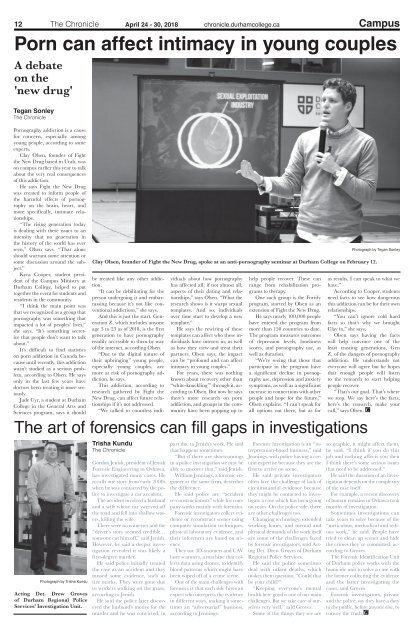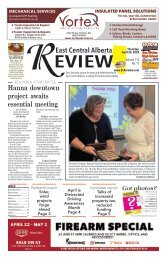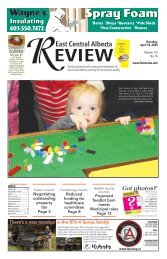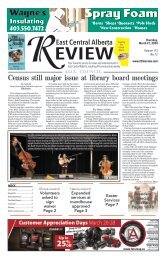Create successful ePaper yourself
Turn your PDF publications into a flip-book with our unique Google optimized e-Paper software.
<strong>12</strong> The <strong>Chronicle</strong> April 24 - 30, 20<strong>18</strong> chronicle.durhamcollege.ca Campus<br />
Porn can affect intimacy in young couples<br />
A debate<br />
on the<br />
'new drug'<br />
Tegan Sonley<br />
The <strong>Chronicle</strong><br />
Pornography addiction is a cause<br />
for concern, especially among<br />
young people, according to some<br />
experts.<br />
Clay Olsen, founder of Fight<br />
the New Drug based in Utah, was<br />
on campus earlier this year to talk<br />
about the very real consequences<br />
of this addiction.<br />
He says Fight the New Drug<br />
was created to inform people of<br />
the harmful effects of pornography<br />
on the brain, heart, and<br />
more specifically, intimate relationships.<br />
“The rising generation today<br />
is dealing with these issues to an<br />
intensity that no generation in<br />
the history of the world has ever<br />
seen,” Olsen says. “That alone<br />
should warrant some attention or<br />
some discussion around the subject.”<br />
Kyra Cooper, student president<br />
of the Campus Ministry at<br />
<strong>Durham</strong> College, helped to put<br />
together the event for students and<br />
residents in the community.<br />
“I think the main point was<br />
that we recognized as a group that<br />
pornography was something that<br />
impacted a lot of peoples’ lives,”<br />
she says. “It’s something secretive<br />
that people don’t want to talk<br />
about.”<br />
It’s difficult to find statistics<br />
on porn addiction in Canada because<br />
until recently, this addiction<br />
wasn’t studied as a serious problem,<br />
according to Olsen. He says<br />
only in the last few years have<br />
doctors been treating it more seriously.<br />
Jade Cyr, a student at <strong>Durham</strong><br />
College in the General Arts and<br />
Sciences program, says it should<br />
Photograph by Trisha Kundu<br />
Acting Det. Drew Groves<br />
of <strong>Durham</strong> Regional Police<br />
Services' Investigation Unit.<br />
be treated like any other addiction.<br />
“It can be debilitating for the<br />
person undergoing it and embarrassing<br />
because it’s not like conventional<br />
addictions,” she says.<br />
And this is just the start. Generation<br />
Z, which includes anyone<br />
age 3 to 23 as of 20<strong>18</strong>, is the first<br />
generation to have pornography<br />
readily accessible to them by way<br />
of the internet, according Olsen.<br />
“Due to the digital nature of<br />
their upbringing” young people,<br />
especially young couples, are<br />
more at risk of pornography addiction,<br />
he says.<br />
This addiction, according to<br />
research gathered by Fight the<br />
New Drug, can affect future relationships<br />
if it’s not addressed.<br />
“We talked to countless individuals<br />
about how pornography<br />
has affected all, if not almost all,<br />
aspects of their dating and relationships,”<br />
says Olsen. “What the<br />
research shows is it warps sexual<br />
templates. And so, individuals<br />
over time start to develop a new<br />
template.”<br />
He says the rewiring of these<br />
templates can affect who these individuals<br />
have interest in, as well<br />
as how they view and treat their<br />
partners. Olsen says, the impact<br />
can be “profound and can affect<br />
intimacy in young couples.”<br />
For years, there was nothing<br />
known about recovery other than<br />
“white-knuckling’” through it, according<br />
to Olsen. But now he says<br />
there’s more research on porn<br />
addiction, and groups in the community<br />
have been popping up to<br />
help people recover. These can<br />
range from rehabilitation programs<br />
to therapy.<br />
One such group is the Fortify<br />
program, started by Olsen as an<br />
extension of Fight the New Drug.<br />
He says nearly 100,000 people<br />
have entered the program from<br />
more than 150 countries to date.<br />
The program measures outcomes<br />
of depression levels, loneliness<br />
scores, and pornography use, as<br />
well as duration.<br />
“We’re seeing that those that<br />
participate in the program have<br />
a significant decline in pornography<br />
use, depression and anxiety<br />
symptoms, as well as a significant<br />
increase in connections with other<br />
people and hope for the future,”<br />
Olsen explains. “I can’t speak for<br />
all options out there, but as far<br />
Photograph by Tegan Sonley<br />
Clay Olsen, founder of Fight the New Drug, spoke at an anti-pornography seminar at <strong>Durham</strong> College on February <strong>12</strong>.<br />
as results, I can speak to what we<br />
have.”<br />
According to Cooper, students<br />
need facts to see how dangerous<br />
this addiction can be for their own<br />
relationships.<br />
“You can’t ignore cold hard<br />
facts so that’s why we brought<br />
Clay in,” she says.<br />
Olsen says having the facts<br />
will help convince one of the<br />
least trusting generations, Gen<br />
Z, of the dangers of pornography<br />
addiction. He understands not<br />
everyone will agree but he hopes<br />
that enough people will listen<br />
to the research to start helping<br />
people recover.<br />
“That’s our goal. That’s where<br />
we stop. We say here’s the facts,<br />
here’s the research, make your<br />
call,” says Olsen.<br />
The art of forensics can fill gaps in investigations<br />
Trisha Kundu<br />
The <strong>Chronicle</strong><br />
Gordon Jenish, president of Jenish<br />
Forensic Engineering in Oshawa,<br />
has investigated many cases. He<br />
recalls one story from early 2000s<br />
when he was contacted by the police<br />
to investigate a car accident.<br />
The accident involved a husband<br />
and a wife whose car swerved off<br />
the road and fell into shallow waters,<br />
killing the wife.<br />
There were no witnesses and the<br />
“driver’s story seemed credible…<br />
someone cut him off,” said Jenish.<br />
However, he said a deeper investigation<br />
revealed it was likely a<br />
first-degree murder.<br />
He said police initially treated<br />
the case as an accident and they<br />
missed some evidence, such as<br />
tire marks. They were gone due<br />
to workers walking on the grass,<br />
according to Jenish.<br />
He said the police later discovered<br />
the husband’s motive for the<br />
murder and he was convicted, in<br />
part due to Jenish’s work. He said<br />
that happens sometimes.<br />
“But if there are shortcomings<br />
in a police investigation we may be<br />
able to uncover that,” said Jenish.<br />
William Jennings, a forensic engineer<br />
at the same firm, describes<br />
the difference.<br />
He said police are “accident<br />
re-constructionists” while his company<br />
works mainly with forensics.<br />
Forensic investigators collect evidence<br />
or reconstruct scenes using<br />
computer simulation techniques,<br />
physical laboratory evidence, and<br />
their inferences are based on science.<br />
They use 3D-scanners and UAV<br />
laser scanners, a machine that collects<br />
data using drones, to identify<br />
blood patterns which might have<br />
been wiped off of a crime scene.<br />
One of the main challenges with<br />
forensics is that each side hires an<br />
expert who interprets the evidence<br />
in different ways, making it sometimes<br />
an “adversarial” business,<br />
according to Jennings.<br />
Forensic investigation is an “interpretation-based<br />
business,” said<br />
Jennings, with police having a certain<br />
expertise because they are the<br />
first to arrive on scene.<br />
He said private investigators<br />
often face the challenge of lack of<br />
circumstantial evidence because<br />
they might be contacted to investigate<br />
a case which has been going<br />
on years. On the police side, there<br />
are other challenges too.<br />
Changing technology, extended<br />
working hours, and mental and<br />
physical demands of the work itself<br />
are some of the challenges faced<br />
by forensic investigators, said Acting<br />
Det. Drew Groves of <strong>Durham</strong><br />
Regional Police Services.<br />
He said the police sometimes<br />
deal with infant deaths, which<br />
makes them question, “Could that<br />
be your child?”<br />
“Keeping everyone’s mental<br />
health here good is one of our main<br />
challenges. But we take care of ourselves<br />
very well,” said Groves.<br />
Some of the things they see are<br />
so graphic, it might affect them,<br />
he said. “I think if you do this<br />
job and nothing affects you then<br />
I think there’s some serious issues<br />
that need to be addressed.”<br />
He said the duration of an investigation<br />
depends on the complexity<br />
of the case itself.<br />
For example, a recent discovery<br />
of human remains in Oshawa took<br />
months of investigation.<br />
Sometimes investigations can<br />
take years to solve because of the<br />
“meticulous, methodical and tedious<br />
work,” he said. People have<br />
tried to clean up scenes and hide<br />
the crimes they’ve committed, according<br />
to Groves.<br />
The Forensic Identification Unit<br />
of <strong>Durham</strong> police works with the<br />
homicide unit to solve a case with<br />
the former collecting the evidence<br />
and the latter investigating the<br />
cases, said Groves.<br />
Forensic investigators, private<br />
and the police, say they have a duty<br />
to the public, before anyone else, to<br />
convey the truth.


















